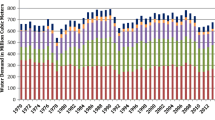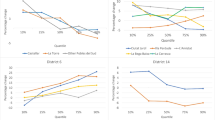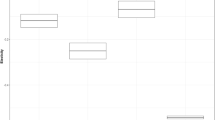Abstract
To date, the results of studies which attempted to estimate residential water demand models have varied, but the source of these variations is not evident because the studies have applied different methodologies and data bases to different regions. The purpose of this paper is to develop models of residential water demand for watershed regions and test the null hypothesis that a single model is adequate to explain variations for all of the individual regions. Primary data collected from questionnaires and utility company records is used in a regression analysis to estimate a generalized water demand model for the state as well as one for each of the subregions. The null hypothesis is rejected which indicates that there are other factors which influence the demand for water and the use of a single model could result in biased estimates.
Similar content being viewed by others
References
Andrews, Donald R. and Gibbs, Kenneth C., “An Analysis of the Effect of Price on Residential Water Demand: Metropolitan Miami, Florida.”Southern Journal of Agricultural Economics 12 (July 1975): 121–142.
Dunn, James E. (Unpublished Manuscript), “Methods of Multivariant Analysis.”
Foster, Henry and Beattie, Bruce R., “Urban Residential Demand for Water in the United States,”Land Economics 55 (February 1979): 43–58.
Gottlieb, Manuel, “Urban Domestic Demand for Water: A Kansas Case Study.”Land Economics 39 (May 1963): 204–210.
Hanke, S. H. and de Mare, L., “Residential Water Demand: A Pooled, Time-Series, Cross-Section Study of Malmo, Sweden,” in Kindler, J. and Russell, C. S. (eds.)Modelling Water Demands, New York: John Wiley & Sons (forthcoming 1981)
Hanke, S. H. and Mehrez, A., “An Optimal Sampling Procedure for the Collection of Residental Water use Data.”Water Resource Research 15 (Dec. 1979): 1343–1348.
Howe, Charles W. and Linaweaver, F. P., “The Impact of Price on Residential Water Demand and Its Relation to System Design and Price Structure.”Water Resource Research 3 (1967): 13–32.
Seidel, H. F. and Bauman, E. R., “A Statistical Analysis of Water Works Data for 1955.”Journal of American Water Works Association 49 (Dec. 1957): 1531–1566.
Sewell, W. R. Derrick and Rouche, Leonard, “Peak Load Pricing and Urban Water Management: Victoria, B.C., A Case Study.”Natural Resources Journal 14 (July 19764): 383–400.
Taylor, L., “The Demand for Electricity: A Survey.”Bell Journal of Economics 6 (1975): 74–110.
Turnovsky, Stephen J., “The Demand for Water: Some Empirical Evidence on Consumer Response to a Commodity Uncertain in Supply.”Water Resources Research 5 (April 1969): 350–361.
Ware, James E. and North, Ronald M., “Price and Consumption of Water for Residential Use in Georgia.”The Atlantic Economic Review 15 (Oct. 1968): 9–13.
Wong, S. T., “A Model of Municipal Water Demand: A Case Study of Northeastern Illinois.”Land Economics 48 (Feb. 1972): 98–113.
Author information
Authors and Affiliations
Rights and permissions
About this article
Cite this article
Ford, R.K., Ziegler, J.A. Intrastate differences in residential water demand. Ann Reg Sci 15, 20–30 (1981). https://doi.org/10.1007/BF01286329
Received:
Revised:
Issue Date:
DOI: https://doi.org/10.1007/BF01286329




